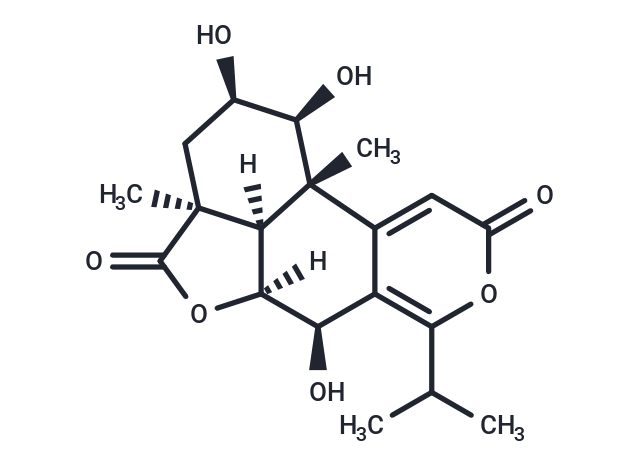Shopping Cart
- Remove All
 Your shopping cart is currently empty
Your shopping cart is currently empty

Nagilactone B is extracted from the root bark of Podocarpus nagi and it also is a liver X receptor (LXR) agonist.

| Pack Size | Price | Availability | Quantity |
|---|---|---|---|
| 2 mg | $1,298 | 7-10 days |
| Description | Nagilactone B is extracted from the root bark of Podocarpus nagi and it also is a liver X receptor (LXR) agonist. |
| In vitro | Nagilactone B (NLB) significantly ameliorates intracellular lipid accumulation. Nagilactone B (0.02, 0.1, and 0.5?μM) markedly promotes cholesterol efflux to extracellular apolipoprotein A-I (apoA-I) and high density lipoprotein (HDL) with maximal 5.72- (P<0.05) and 2.34-fold (P<0.01), respectively. RAW264.7 cells are co-incubated with oxLDL (20?μg/mL) and Nagilactone B (0.02, 0.1, and 0.5?μM) for 24?h. ORO positive areas are reduced by 30.05±7.49 (P<0.01), 47.25±5.39 (P<0.001), and 48.65±7.44% (P<0.001) in Nagilactone B (0.02, 0.1, and 0.5 μM)-treated groups, respectively . |
| In vivo | Nagilactone B (NLB) inhibits atherosclerosis in apoE-/- mice by inducing ATP-binding cassette transporter A1 (ABCA1) and G1 (ABCG1) mediated cholesterol efflux in macrophages. Nagilactone B treatment (10 and 30 mg/kg/day) obviously decreases en face aortic lesions, compared with the HFD group by 54.96±10.06% (P<0.01), 71.50±15.37% (P<0.001) in both NLB (L) and NLB (H) groups. In particular, Nagilactone B markedly attenuates atherosclerotic plaque lesion areas in the aortic arch aorta, thoracic aorta, and abdominal aorta [P<0.01 in NLB (H) group]. Male apoE-deficient mice on C57BL/6J background receive Nagilactone B (10 and 30?mg/kg) for 12 weeks. Compared with the model group, Nagilactone B treatment (10 and 30?mg/kg) significantly decreases en face lesions of total aorta areas. Six-week-old male apoE-/- mice on an HFD are randomized to receive Atorvastatin (10 mg/kg/day), Nagilactone B (10 and 30?mg/kg/day), or CMC-Na for 12 weeks. Mice on a chow diet are administered CMC-Na as the normal diet control group . |
| Molecular Weight | 364.39 |
| Formula | C19H24O7 |
| Cas No. | 19891-51-1 |
| Relative Density. | 1.42 g/cm3 (Predicted) |
| Storage | Powder: -20°C for 3 years | In solvent: -80°C for 1 year | Shipping with blue ice. |

Copyright © 2015-2025 TargetMol Chemicals Inc. All Rights Reserved.